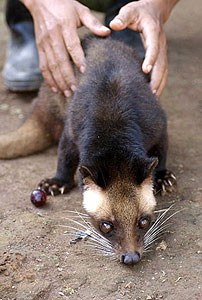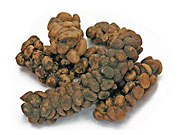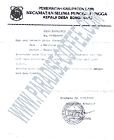Nine thousand three hundred and twenty
one miles from San Felipe there’s a small mammal
that looks like the love child of a raccoon and a fat
fox. For many java lovers, the furry fundament of this
beady-eyed critter is the official dispenser of the
world’s finest and most exotic coffee. Kopi Luwak
is the name of this magical product, kopi meaning
coffee and luwak, the all-regional Indonesian
name for the cat-like animal (Paradoxus hermaphroditus)
that exercises a fondness for coffee beans. Ranging
from four to eleven pounds and largely nocturnal, the
luwak is also known as a luak, musang, toddy cat, civet,
palm civet and civet-cat. Many people believe it is
a wild cat. But it's actually a cousin of the mongoose.
Probably the closest North American counterpart is the
skunk, with which it shares the ability to excrete a
noxious odor from scent glands near it’s anus.
The luwak uses its extremely sensitive button nose to
ferret out only the ripest and most delectable coffee
cherries (the bright red berries produced by coffee trees).
During its nocturnal shopping along the arboreal aisles
of coffee plantations, it will eat only a small fraction
of the berries offered, leaving the inferior ones to less
discrete consumers like Starbuck’s and Peet’s.
 Canadian
University of Guelph food scientist Massimo Marcone (the
Indiana Jones of the comestible world) went to Indonesia
to collect samples of kopi luwak beans with his own hands.
He retired them to his laboratory, a CSI look-alike environment,
where he proceeded to fingerprint proteins and search
for chemical trails using gas and liquid chromatographers.
Employing common coffee beans as exemplars, he was shocked
to discover that the beans derived from the luwak scat
hosted fewer bacteria than the control samples. Marcone’s
studies supplied independent confirmation that kopi luwak
undergoes physical and chemical changes as a result of
digestion. They become harder and more brittle, with an
extremely finely perforated outer surface, and have a
lower protein content, theoretically resulting in a less-bitter
cup. Canadian
University of Guelph food scientist Massimo Marcone (the
Indiana Jones of the comestible world) went to Indonesia
to collect samples of kopi luwak beans with his own hands.
He retired them to his laboratory, a CSI look-alike environment,
where he proceeded to fingerprint proteins and search
for chemical trails using gas and liquid chromatographers.
Employing common coffee beans as exemplars, he was shocked
to discover that the beans derived from the luwak scat
hosted fewer bacteria than the control samples. Marcone’s
studies supplied independent confirmation that kopi luwak
undergoes physical and chemical changes as a result of
digestion. They become harder and more brittle, with an
extremely finely perforated outer surface, and have a
lower protein content, theoretically resulting in a less-bitter
cup.
In another study cited by a food research article, an
"electronic nose analysis" was able to detect
differences between kopi luwak and undigested coffees,
which may help confirm a particular batch's authenticity.
 Because
of the faddish attention directed at it, kopi luwak beans
tend to spike the retail charts at $150-$500 a pound.
This attracts a lot of confidence men, who these days
take up ethereal residence on the internet. Marcone, who
has become a leading expert on kopi luwak, can examine
the beans under an electron microscope and determine from
its striations whether a civet excreted it or not. His
investigations revealed that about 42% of the kopi luwak
being sold as legitimate was completely fake or actual
luwak beans adulterated with common coffee beans. Since
a pound of civet droppings yields less than 5 ounces of
beans and roasting reduces the quantity by an additional
20%, the quantity of harvested and processed kopi luwak
is understandably modest. It's been assessed at a mere
500 to 1,000 pounds on the global market each year. Because
of the faddish attention directed at it, kopi luwak beans
tend to spike the retail charts at $150-$500 a pound.
This attracts a lot of confidence men, who these days
take up ethereal residence on the internet. Marcone, who
has become a leading expert on kopi luwak, can examine
the beans under an electron microscope and determine from
its striations whether a civet excreted it or not. His
investigations revealed that about 42% of the kopi luwak
being sold as legitimate was completely fake or actual
luwak beans adulterated with common coffee beans. Since
a pound of civet droppings yields less than 5 ounces of
beans and roasting reduces the quantity by an additional
20%, the quantity of harvested and processed kopi luwak
is understandably modest. It's been assessed at a mere
500 to 1,000 pounds on the global market each year.
"Real kopi luwak has a top note of rich, dark
chocolate, with secondary notes that are musty and earthy",
Marcone said. "Other coffees, such as Jamaican
Blue Mountain, may score better on official cupping tests
that judge qualities such as aroma, taste and fragrance,"
he added, "But they don't come with quite the
exotic cachet of civet brew." An Indonesian
coffee lover described the scent as the smell of moist
earth after a rainfall, with hints of vanilla that tease
the palate for hours after the cup is empty.
The rarity of genuine kopi luwak will certainly grow
as the civet populations decrease. In Indonesia, civets
are struggling along with much of the country's wildlife
to hold onto their habitat as human influences encroach.
Farmers who scratch out a living harvesting pepper, cacao,
coffee and rubber on an Indonesian mountainside do not
view civet scat lying in the dirt and dead leaves as a
bankable commodity. More aggressive civets will often
raid a farmer's chickens. And because coffee is a seasonal
crop, the animals will eat cacao, bananas, papaya and
other fruits. Most Indonesians believe the only good civet
is a dead civet.
"They're a farmer's enemy," said Ponirin
Suparlan, 45, a barefoot farmer who earns $600 a year
from rubber and coffee trees, and any civet droppings
he finds. He would rather eat a civet than let it dine
on his crops. "If I find one, I will surely kill
it."
Villagers aren't sure how many wild civets are left,
but the population is obviously shrinking because the
dung is getting harder to find each year. Still, a small-time
collector like Suparlan can earn about $3 a kilo, roughly
twice as much as they get for regular coffee. It's a pittance
compared to what foreign buyers earn, often after cutting
it with regular coffee to boost their profits in places
such as Taiwan, Japan, South Korea and the United States.
In Indonesia, local lore reports that villagers who were
forced to work on Dutch plantations centuries ago discovered
that beans from civet droppings rendered a smooth cup
of coffee. Since the workers were required to surrender
everything they picked to their colonial masters, civet
scat provided the only coffee they could scrounge for
themselves. Today the coffee is reportedly enjoyed by
the British royal family and a single cup can sell for
$30 at a five-star hotel in Hong Kong.
 |
 |
This summer, rather than fly to a 5-star Hong Kong hotel,
I purchased a hundred grams of kopi luwak from a website
I found on the internet. I shopped around first, reading
the endless guarantees and promises of authenticity and
eventually stumbled onto a site that actually posted links
to certificates, which I believed enhanced their legitimacy.
Only later did I discover, upon closer examination of
the documents (one of which was in the Malay language),
that they were a business permit and a food testing result
of the 'Filth & Extraneous Analysis' type. At best
they proved that something was analyzed which
the records described as Kopi Luwak.
The small bag of vacuum-sealed beans, which shipped out
of Jakarta, took quite a while to reach its buyer but
ultimately they arrived and that afternoon I stood reverently
fondling them in front of the coffee grinder. I stood
there for some time, reluctant to open the package. The
psychological exotica attached to the beans nearly had
me deliver them to a mahogany shadow box or some similar
enshrinement. Then the notion was overwhelmed by the thought
of a really good cup of coffee, a great cup of
coffee, the best cup of coffee. ``It's the rarest
beverage in the world", affirmed Mark Mountanos,
president of southern California's coffee wholesaler M.P.
Mountanos. Well, at least if it wasn't the best,
it would be the most exclusive.
I scissored the edge off the bag, which immediately relaxed
the interlocked beans and they fell into casual relationships,
like a pocket full of wood beads. It suddenly occurred
to me I had no idea how much I should grind for a four
cup pot of coffee. So I went back to the internet, which
was reluctant to supply any useful formulae. I found two
references that were worlds apart.
- Use finely ground beans. Place 1/2 teaspoon (2gm)
coffee in a cup, pour boiling water over it, stir and
allow to settle before drinking.
- Give the beans a course grind and mix seven grams
of coffee with four ounces of hot water in a cup.
Coffee, like any art or barber, is an entirely subjective
experience. I reasoned that changing a car shouldn't require
changing the road, so I used the same coffee grinder (after
a good cleaning) and the same drip coffee maker.
I gathered a few friends to sample the end product. And
here is where coffee can help lift the hem of the robe
that veils our reality. The eyes and hearts that surround
you usually out-vote your perceptions. In fact, they help
create them.
Once they learned the dark secret of kopi luwak, my collaborators
were unanimously derisive and mocking.
"It smells like a litter box," one of them
commented.
"You sure these weren't harvested under a rabbit
hutch?" said another, narrowly eying the remaining
beans in the bag. And so on.
My first cup of kopi luwak was tainted by prejudice and
resistance. It looked weak to me, tasted like hot water
and smelled like shower steam. But the second
cup was a different story.
About a week later I was visited by an old girlfriend
and explained to her the coffee's peculiar pedigree. She
was immediately interested and I ceremoniously prepared
a small pot, adding more beans than my first attempt.
"It smells great," she remarked, holding her
pretty nose a few inches above the cup. This surprised
me. My first cup didn't impress my own nozzling analysis
so I hung my neb over my own cup and was instantly rewarded
with a humid, exotic bouquet. "It does,
doesn't it?" I agreed.
We sat across from each other and used the cups to warm
our hands as the coffee cooled a little. We talked about
old times as I slowly filled with a fuzzy familiarity,
remembering intimate evenings and low, whispered endearments.
Her blue eyes followed my cup and the kopi luwak washed
over my tongue like a satin celebration.
The second thing I noticed (the first was how little
her blue eyes had changed) was its smoothness, its utter
lack of acidity. Most coffee houses consider acidity a
virtue and some of them smelt such ulcerous potions that
they border on pure sainthood. The kopi luwak offered
no hint of that kind of battery heritage. It was balanced,
stylish and friendly.
The next thing I noticed was the intricacy of its flavor.
There was something cosmopolitan about it, a wide yet
select combination of savory influences. It had a heavy
richness. If it had to be described in personal terms,
the words gifted or talented come to
mind.
My friend voiced a similar impression. We couldn't agree
with Massimo Marcone's 'musty and earthy' description,
but we definitely detected a hint of chocolate in its
aroma. Coffee connoisseur Chris Rubin was reportedly impressed
by its taste. "The aroma is rich and strong, and
the coffee is incredibly full bodied, almost syrupy,"
he said. "It's thick with a hint of chocolate, and
lingers on the tongue with a long, clean aftertaste. It's
definitely one of the most interesting and unusual cups
I've ever had."
My old girlfriend and I sat across the table
from each other and indulged in the atmosphere. It was
strong. It was complex. And there was definitely something
syrupy about it.
|